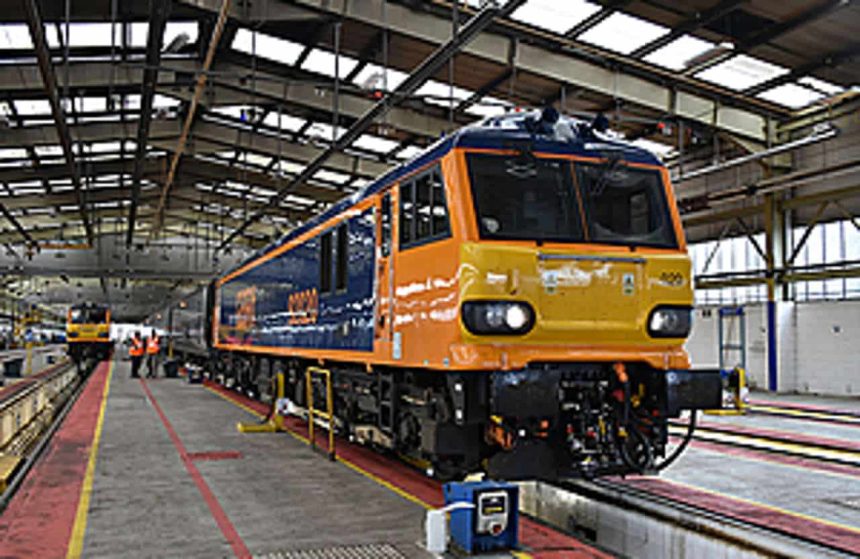The Rail Accident Investigation Branch (RAIB) has released its report into an incident where a Caledonian Sleeper train didn't stop at Edinburgh Waverley station.
At around 07:25 on Thursday 1st August 2019, the driver of the Edinburgh section of the Lowlander Caledonian Sleeper service from London Euston was not able to control the trains speed on approach to Edinburgh.
The driver was also unable to follow the speed limit at Haymarket East Junction and would have been unable to stop the train before the junction if there had been another train heading through the junction at the same time.
The train was also then unable to stop at Edinburgh Waverley and came to a stop around 650 metres after Platform 11 at Edinburgh Waverley, and only stopped when the train manager operated emergency brake button in a coach.
The train crew found that an air isolation cock between the locomotive and coaches was closed when it should have been open.
After finding the issue, and obtaining permission from the signaller, the train reversed back into the station where the passengers alighted. No damage or injuries were reported.
The driver was unable to stop the train because the brake pipe isolating cock on the leading end of the front coach was closed, this prevented the brakes on all coaches from operating.
The isolating cock became closed during coupling operations when the Edinburgh section was split from the Glasgow train at Carstairs. The happened after the brake test had been complete; therefore, the closure was undetected prior to departure from Carstairs.
The brake system on the locomotive masked the lack of coach brakes until the train was approaching Slateford, near Edinburgh.
The RAIB has made two recommendations; one was addressed to the RSSB to change the wording in the rules to make it clear a brake test should be done after all coupling activities had been completed.
The second recommendation was addressed to Caledonian Sleeper to review the vulnerability of the isolating cocks on its coaches to prevent the wrong operation by people or objects.
Along with the recommendations, a number of learning points were identified, relating to procedures, running the brake test, the ‘train in distress' signal and recording data.
Where Next?
RailAdvent Plus
Get image downloads, Prints and Streaming Video
News Homepage
For the Latest Railway News
RailAdvent Online Shop
Framed Prints, DVD's / Blu-Ray's and more
LocoStop Community
Come and share your railway pictures
Mainline Steam Info
Upcoming mainline steam tours/loco movements
Network Rail
Visit their website

one best recommendation is that after departuring from station,,,driver has to be checked its brake after achieving some speed and than aft
Really down to simple physics, 11 mph reduction of velocity in 28 seconds. This gives a deceleration of 0.17 metres per second squared. A decent running brake test should be at least 0.5 metres per second square, would of highlighted the issue. This magnitude will not tip the customers out of bed. The class 92 has a brake force of 63 Tonnes. The consist mass would be about 478 tonnes. Newton’s second law works out as 0.17 rate of deceleration, absolutely matches.
Statutory lnstrument 1798 TDLCR, states understand braking performance and calculation. Industry non-compliance is rife.
Had this unfortunate driver been trained to the madated standard, he would still have a clean safety case. After 40 years driving I feel for him.
Why is there no indicator in the cab to let the driver know he has full air pressure in the train.if not it should not be possible to release the brake s on the locomotive to drive the train
dear pressure indicator gauge is available in engine cab….loco pilot has to look it thoroughly,,,but in this case it is out of mind that there is also one gauge in last coach also called this coach brake vane guard is sitting there in this coach and control whole train
.
At our work whenever we put a air system on a main line to feed machines and if the valve was closed therefore NO air in the breaking area in this case, a preset pressure sensor would detect there is NO air and a blue neon light would display above the machine. The cost was more in time to wire it in as the cost of the part. Get from R.S components
Why don’t they have self sealers as fitted to all artic lorry trailers and units ?
Do you know what caused the brake problems on the Caledonian Sleeper Class 92 locomotive. Something to look out for if it might of caused a accident at Edinburgh Waverley.
Andrew, the cause of the incident is clearly stated in the article.
Do you ever read the articles or do you just look at the pictures?
Mind your own business pal.
Oops. That doesn’t sound good. Oh dear.
Running brake test raised as an issue; was it done or not? If not, why? Such tests vary considerably from driver to driver, and ineffectual ones should be picked up on regular data recorder downloads, assuming that theses, too, are being done on a planned basis. Some designs of train pipe isolating cocks prevent accidental closure and should;d be mandatory?
‘Learning points’ identified, including running brake test; was this carried out, if not, why not? Running brake tests vary considerably from driver to driver, and ineffectual ones should be picked up on routine data recorder downloads, assuming that theses, too, are done as often as they should be. No operator should take their eye off the ball where driving cab discipline is involved.